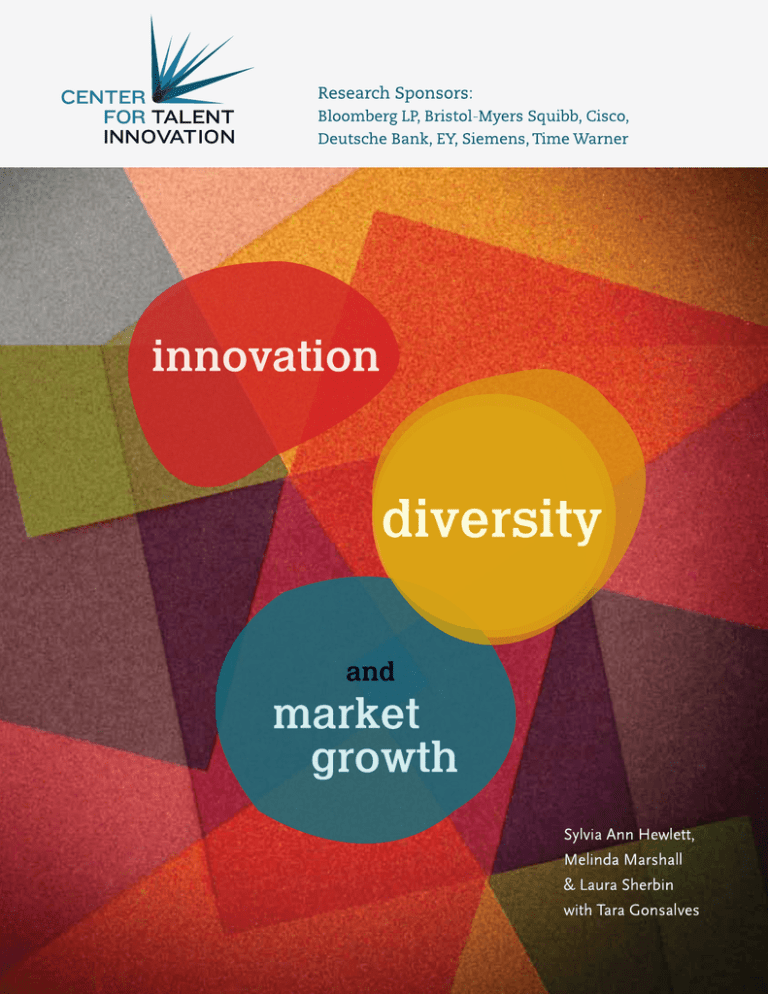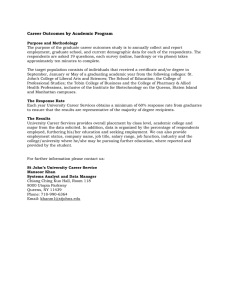
TASK FORCE FOR TALENT INNOVATION
CO-CHAIRS
MEMBERS
American Express
Bank of America Merrill Lynch
Bloomberg LP
Booz Allen Hamilton
Bristol-Myers Squibb
Cisco Systems
Deloitte
Deutsche Bank
EMD Serono
EY
GE
Goldman Sachs
Intel Corporation
Johnson & Johnson
NBCUniversal
Time Warner
Unilever plc
AIG
AllianceBernstein
ArcelorMittal
AT&T
Barclays plc
BlackRock
Boehringer Ingelheim USA
Booz & Company
BP
BT Group*
Cardinal Health
Central Intelligence Agency
Chubb
Citi*
Covidien
Credit Suisse*
Depository Trust &
Clearing Corporation
Eli Lilly and Company
Federal Reserve Bank of New York
Fidelity Investments
Freddie Mac
Gap Inc.
Genentech
General Mills
Genpact
Google
Hess Corporation
Hewlett-Packard
HSBC Bank plc
International Monetary Fund
As of September 2013
*Steering Committee
Interpublic Group
Knoll*
KPMG LLP
Marie Claire
McGraw-Hill Companies
McKesson Corporation
McKinsey & Company
Moody’s Foundation*
Morgan Stanley
New York Times
Company
Northrop Grumman
Novartis Pharmaceuticals
Corp.
Osram
Pfizer Inc.*
QBE North America
Schlumberger
Siemens AG
Sodexo
Standard Chartered Bank
Swiss Reinsurance Co.
Thomson Reuters
Towers Watson
Tupperware Brands
UBS*
United Nations DPKO/
DFS/OHRM
Vanguard
Viacom
White & Case LLP
Withers LLP
WPP
Executive
Summary
Executive
Summary
W
hat does it take to win in the global marketplace?
For virtually all companies regardless of sector, competitive strength and
market growth depend on innovation. Gaining market share and expanding into
new markets hinges on winning over new consumers or clients by identifying
unmet needs and developing new products, services, and systems to fill them.
Greater productivity may boost earnings, but in today’s fiercely competitive
global economy, it is serial innovation that drives and sustains growth.
But what drives serial innovation? CTI’s ground-breaking research reveals
the engine to be a diverse workforce that’s managed by leaders who cherish
difference, embrace disruption, and foster a speak-up culture. Inclusive leader
behaviors effectively “unlock” the innovative potential of an inherently
diverse workforce, enabling companies to increase their share of existing
markets and lever open brand new ones. By encouraging a proliferation of
perspectives, leaders who foster a speak-up culture also
enable companies to realize greater efficiencies
and trim costs—another way that
Two-dimensional (2D) diversity
innovation drives bottom-line value.
describes leadership that exhibits at
least three kinds of both:
&
Inherent diversity (gender, race, age,
religious background, socioeconomic
background, sexual orientation,
disability, nationality)
Acquired diversity (cultural fluency,
generational savvy, gender smarts, social
media skills, cross-functional knowledge,
global mindset, military experience,
language skills)
Employees who report
that their ideas…
Win endorsement from decision-makers
63% vs. 45%
Get developed or prototyped
48% vs. 30%
Leaders have long recognized that an
Get deployed into the marketplace
inherently diverse workforce (inclusive of
% vs.
women, people of color, gay individuals) confers
a competitive edge in terms of selling products
(% respondents at companies WITH 2D diversity
in leadership vs. % respondents at companies
or services to diverse end users—what’s known
WITHOUT 2D diversity in leadership)
as “matching the market.” Our research shows,
however, that an inherently diverse workforce can be
a potent source of innovation, as diverse individuals are
better attuned to the unmet needs of consumers or clients
like themselves. Indeed, their insight is critical to identifying and
addressing new market opportunities. We find that when teams have one or
more members who represent the gender, ethnicity, culture, generation, or
sexual orientation of the team’s target end user, the entire team is far more
likely (as much as 158% more likely) to understand that target, increasing
their likelihood of innovating effectively for that end user.
35
20%
Market-worthy ideas, however, aren’t innovation until they’re developed
and deployed into the marketplace. To get to market, ideas require the
buy-in and endorsement of decisionmakers at every level. And that’s
where acquired diversitySM plays
Team members who report
such a vital role in transforming
that their leader…
ideas into innovation. Leaders who
have acquired diversity—whose
vs.
Ensures
that
everyone
speaks
up and gets heard
background and experience has
conferred on them an appreciation
vs.
for difference, whether that
Makes it safe to risk proposing novel ideas
difference is rooted in gender, age,
culture, socioeconomic background,
vs.
Empowers team members to make decisions
nationality, or sexual orientation—
63% 29%
74% 34%
82% 40%
are significantly more likely to behave
inclusively than leaders who lack it.
64% vs. 25%
Takes advice and implements feedback
73% vs. 30%
Gives actionable feedback
64% vs. 27%
Shares credit for team success
(% respondents whose leader has at least three acquired diversity traits
vs. % respondents whose leader has NO acquired diversity traits)
Six inclusive behaviors, we find, are highly correlated with a “speak-up”
culture, or an organizational environment where everyone feels free to
volunteer opinions, suggest unorthodox approaches, or propose
solutions that fly in the face of established practice. Leaders
who exhibit at least three of these six behaviors unlock
innovative capacity by unlocking the full spectrum
of perspectives, opinions, and toolkits that diverse
Team members who
report that they feel…
individuals bring to problem-solving. While critical
at the team level, such leaders are especially
Welcome and included in their team
transformative at the top, because they’re the
% vs.
ones who determine organizational culture by
socializing their behaviors. Brilliant individuals
Free to express their views and opinions
and high-performing teams cannot deliver in a
% vs.
culture where channels for experimentation don’t
exist,
failure is penalized, and the loudest voice in
That their ideas are heard and recognized
the room is that of the leader.
87
51%
87
46%
74% vs. 37%
Indeed, our research shows that when leadership
lacks innate or acquired diversity, or fails to foster
a speak-up culture, fewer ideas with market potential
make it to market. Ideas from women, people of color,
LGBTs, and Gen-Ys are less likely to win the endorsement
they need to go forward because 56% of leaders don’t value
ideas they don’t personally see a need for—a veritable chokehold
when an organization’s leaders are predominantly Caucasian, male, and
heterosexual, and come from similar educational and socioeconomic
backgrounds. In short, the data strongly suggest that homogeneity stifles
innovation. Fully 78% of our survey sample work for such a company.
(% respondents whose leader exhibits at least
three inclusive behaviors vs. % respondents whose
leader exhibits NO inclusive behaviors)
››
›
40
vs.
%
25
Employees who report that…
48
vs.
%
26
Groupthink is a problem
on their team
62
vs.
%
37
Leadership at their company does
not perceive value in ideas they
don’t personally see a need for
Ideas at their firm rarely
make it to market
(% respondents at companies WITHOUT 2D diversity
in leadership vs. % respondents at companies WITH 2D
diversity in leadership)
Companies that harness both innate diversity in their workforce and
acquired diversity in leadership are measurably more innovative
than companies that fail to harness these drivers. Employees at
companies with 2D diversity are more likely than employees at
non-diverse companies to take risks, challenge the status
quo, and embrace a diverse array of inputs. They’re also
Employees who report
75% more likely (35% vs. 20%) to see their ideas move
that their team…
through the pipeline and make it to the marketplace.
Most dramatically, our findings demonstrate a
robust correlation between highly innovative,
diverse companies and market growth. Diversity
pays a handsome dividend: employees at publicly
traded companies with 2D diversity are 70%
more likely (46% vs. 27%) than employees at
non-diverse publicly traded companies to report
that their firm captured a new market in the past
12 months, and 45% more likely (48% vs. 33%) to
report that their firm improved market share in that
same time-frame.
67
vs.
%
40
50
vs.
%
29
43
vs.
%
22
40
vs.
%
21
Embraces the input of a diverse
array of its members
Is not afraid to challenge the
status quo
Is not afraid to fail
Takes risks
(% respondents at companies WITH 2D diversity
in leadership vs. % respondents whose leader
In the final analysis, our research shows, companies
exhibits NO inclusive behaviors)
with multicultural workforces have the means at hand
to grow and sustain innovation. The secret isn’t a surfeit
of creativity, although creativity helps. It isn’t a lone genius,
although genius never hurts. Rather, innovative capacity resides
in an inherently diverse workforce where leaders prize difference, value
every voice, and manage rather than suppress disruption. If innovation is
the Holy Grail, then diversity should be a company’s unrelenting quest.
Employees who report
that in the last 12 months
their firm…
››
48
vs.
%
33
Improved market share
46
vs.
%
27
Captured a new market
(% respondents at publicly traded companies WITH 2D
diversity in leadership vs. % respondents at publicly
traded companies WITHOUT 2D diversity in leadership)
For more information or to purchase the complete report,
INNOVATION, DIVERSITY AND MARKET GROWTH,
visit www.talentinnovation.org
Creative direction /Design: Winer Idea Group
Cover Design: Asha Tyska McLaughlin
© 2013 Center for Talent Innovation. All rights reserved.
Unauthorized reproduction or transmission of any part of this publication in any form or by any means, mechanical or
electronic, is prohibited. The analyses and opinions represented in this report are solely those of the authors.
The Center for Talent Innovation is
a nonprofit think tank based in New
York City. CTI’s flagship project is the
Task Force for Talent Innovation—a
private-sector task force focused
on helping organizations leverage
their talent across the divides of
gender, generation, geography and
culture. The 75 global corporations
and organizations that constitute
the Task Force, representing six
million employees and operating
in 192 countries around the world,
are united by an understanding
that the full realization of the talent
pool is at the heart of competitive
advantage and economic success.
1841 Broadway, Suite 300, New York, NY 10023 | TalentInnovation.org



